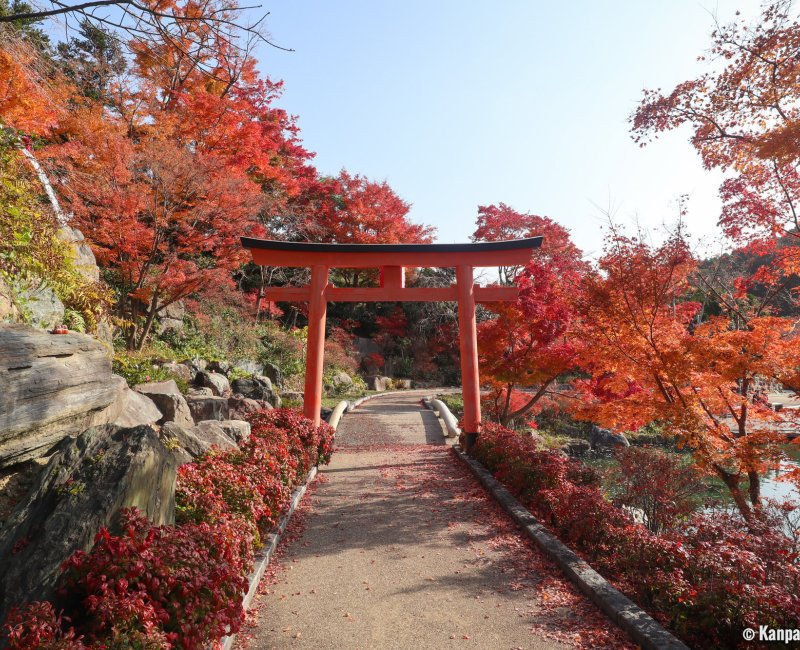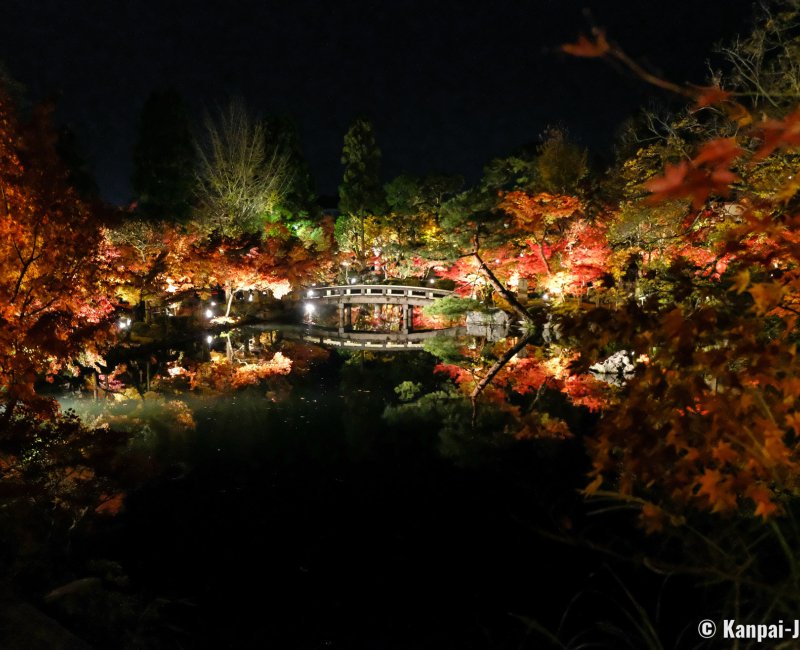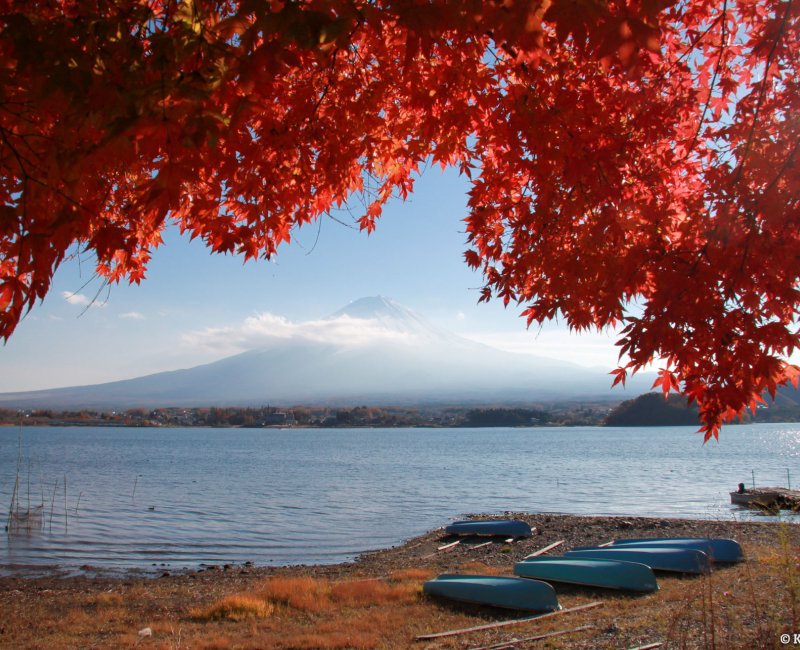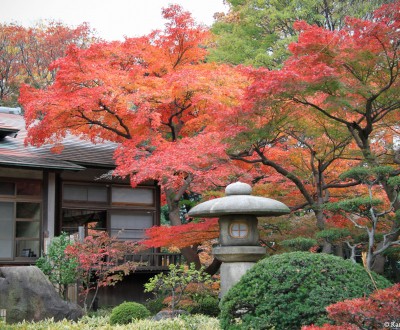Koyo: Japanese maple trees’ red leaves
Momijigari: Contemplating Momiji in the Fall Season
Koyo is a Japanese word to express the maple leaves turning red, fall’s symbol across the entire archipelago. During this change of season, momijigari is a popular tradition for Japanese people to celebrate the second most beautiful season, after the spring and the natural pink shade from cherry trees that characterizes it.
Although spring seems to be the flagship season to travel in Japan, its fall counterpart seems to be lesser known to Japan’s visitors, and it is unfortunate. While the majestic beauty of the cherry trees is not to be forsaken, at the end of autumn, the Japanese maple trees offer such a wonderful show of their foliage reddening that it would be sad not to see it at least once.
First, let’s explain that while the same kanjis are used (紅葉, literally means "deep red leaves"), the term can be read in two different ways:
- momiji 🍁, refering to the tree (maple tree);
- kôyô, that represents the leaf itself.
The contemplation of autumn colors changing (equivalent to ohanami) is called 紅葉狩りmomijigari, literally the "hunt" for this natural chlorophyll transformation.
The Japanese maple tree (Acer japonicum or Acer palmatum) exists in several varieties whose colors can vary from glowing reddish purple to a lighter orange. Its distant cousin, the Ginkgo biloba (銀杏 ichô), whose shades alternate between an old orange or a powerful yellow, sometimes up to a vibrant green, can also be admired.
The combination of these colors result in a very impressive and vibrant display on the daytime, and an even more beautiful show at night when the foliage benefit from a light-up. Here is an interesting fact: Acer, which is easy to breed and take care of, can be cultivated as bonsai.
The maple tree is also used in the culinary field; it offers a delicious wrapping for cakes and other sweets such as mochi or manju.
Maple trees can also be admired from spring to summer when their green leaves appear and provide a pleasant feeling of cool and renewal. The contemplation of such leaves is called ao-momiji in Japanese.

When to admire momiji in the fall?
This custom of contemplation dates back to the Heian period. Due to an aristocratic legacy, it was spread to the people only during Edo period. From the 21st century onward, hordes of foreign tourists come to enjoy this gorgeous quest for colors.
Even though fall lasts from September 21 to December 21 according to the Japanese calendar, the actual period in which you can see the red glow of the leaves usually starts toward the end of this period, from mid-November up to the beginning of December. The fall’s contemplation happens to be longer than the one for spring.
The leaves start to color slightly at the end of August. This natural show is mostly exclusive to September in the northern part of Japan and then progresses down to the southern part of Japan.
Just like for the sakura 🌸, the Japanese weather service is capable of precisely forecasting the beginning of the fall colors, sometimes up to several weeks in advance, and indicate their progression through the country (紅葉前線 koyo zensen). Here are the average days of koyo depending on the region:
At the end of these periods, visiting is still worth it. The leaves might be falling, but they create glowing natural carpets on the ground.
2025 Koyo forecast
Fall 2025 again is expected to come later than usual compared to the previous years average. Thus, the peak foliage might be delayed by a few days due to the residual summer heat and compared to the typical season.
At the beginning of November, the Japanese Meteorological Corporation (JMC) released the following forecast:
- Sapporo: November 6
- Sendai: November 27
- Tokyo: December 2
- Kanazawa: December 2
- Nagoya: December 5
- Osaka: December 7
- Kyoto: December 15
- Hiroshima: November 30
- Fukuoka: December 12
The weather forecast in Japan now distinguishes between the maple trees' red foliage and the ginkgo bilobas' yellow foliage, whose peaks happens a few days earlier, for example in Tokyo around November 27.
Where to do momijigari in Japan?
Once the dates are planned, the main part of momijigari is to decide where to contemplate the leaves.
The best area is Kyoto and its surroundings. However, Ginkgo biloba lovers may not want to forget about Tokyo (as the ginkgo leaf is the city’s hallmark).
Koyo can naturally be found in parks and gardens, including around temples and shrines, if you want to observe them from a closer point of view. Outside cities, numerous hiking paths offer spectacular landscapes along with a rewarding long walk.
Pay attention to crowds, especially in cities! During light-ups (nocturnal illuminations mostly in temples), waiting lines may last up to several hours and it is possible you may not to be able to get inside if you do not queue early enough. Read our visit articles to know the details of each site’s opening hours.

Kyoto and Kansai
- Kyoto: Kiyomizu-dera, Kodai-ji, Tofuku-ji, Shugaku-in, Shinnyudo, Eikando, Nanzen-ji, Yoshimine-dera, Chion-in, Kitano-tenmangu, Koke-dera, Ninna-ji, Fushimi Inari Taisha
- Just around Kyoto: Arashiyama (and its matsuri / festival, the second Sunday of November), Kurama, Daimon-ji
- Yoshinoyama
- Nara: park, Tanzan-jinja, Muro-ji
- Wakayama: Koya-san, Nishinomaru
- Otsu: Hieizan, Enryaku-ji
- Osaka: Minoo Park, Osaka Castle Park
- Ohara: Sanzen-in
Tokyo and surroundings
- Tokyo: Icho-namiki (ginkgo) between Meijijingu-gaien and Aoyama-dori, Rikugi-en, Koishikawa Korakuen, Shinjuku Gyoen, Yoyogi Park and Omotesando, Hama-rikyu, Inokashira Park, Ueno Park, Mukojima Hyakka-en, Gotoku-ji, Kinuta Park, Komazawa Olympic Park, Arisugawa no Miya
- Mount Takao
- Mount Mitake and Okutama (Hatonosu Valley)
- Tachikawa: Showa-Kinen Park
- Kamakura
- Nikko (Ryuzu in particular)
- Oze
- Kokubunji: Tonogayato Garden
- Chiba: Umegase Valley, Yoro Keikoku
- Akigawa Valley
- Nagatoro
Fuji and Central Honshu
- Kawaguchiko
- Hakone
- Tateyama Kurobe
- Korankei
- Kanazawa: Kenroku-en
- Nagoya: castle, Inuyama
- Hikone
- Nagano: Kamikochi, Komoro-jo, Senjojiki
Western and Southern Japan
- Hiroshima: Miyajima, Taishaku-kyo, Sandan-kyo
- Okayama: Go-kei, Kanba
- Shikoku: Konpira-san, Kankakei
- Fukuoka: Hikosan, Kamado-jinja, Komyozen-ji, Shiranoe, Raizan Sennyoji Daihion, Momiji Hachimangu
- Kyushu: Kunenan, Kyusuikei, Kuju, Yabakei
- Tottori Daisen
Northern Japan
- Hokkaido: Daisetsuzan, Shiretoko, Onuma, Noboribetsu, Aoba, Shikotsuko, Akan, Sapporo Nakajima
- Tohoku: Hachimantai, Towada, Hakoda, Chuson-ji, Naruko, Urabandai, Aomori Oirase Keiryu

---
Attention: as for the sakura season, accommodations are booked well in advance, long months before the momijigari period, so it is highly recommended to book your room ASAP!


